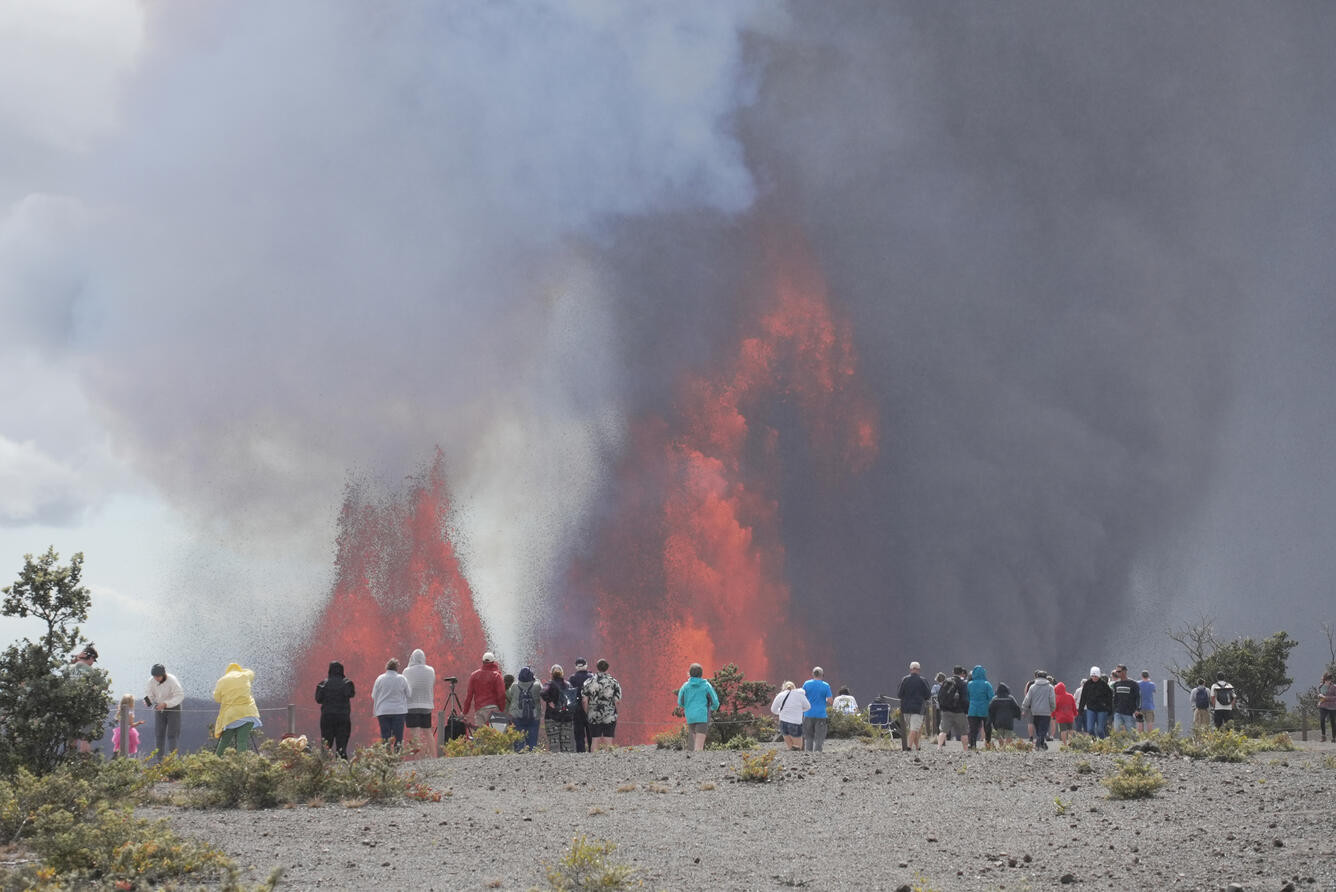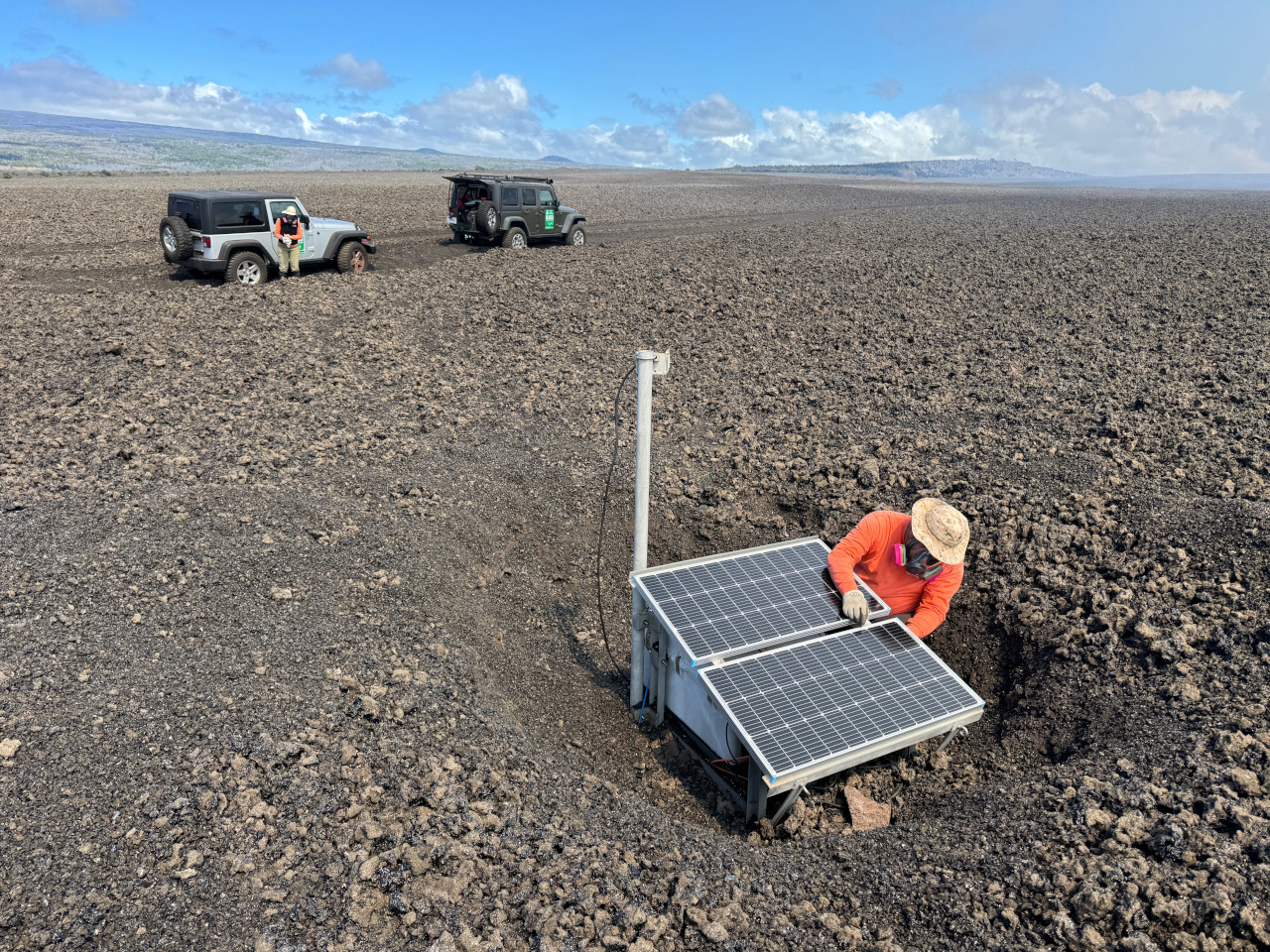
Hawai‘i Volcanoes National Park visitors watch the lava fountains from Uēkahuna overlook on Sunday, November 9. (USGS photo by M. Patrick)
(BIVN) – The recent federal shutdown put a pause on the distribution of the U.S. Geological Survey Hawaiian Volcano Observatory’s Volcano Watch feature. With the government now open, HVO geologist Katie Mulliken catches up on Kīlauea in the return of the weekly article.
From the latest Volcano Watch:
The summit eruption of Kīlauea continues, with 36 episodes of lava fountaining since the eruption began on December 23, 2024. Let’s catch up on the events and hazards associated with the volcano’s most recent few eruptive episodes, and review the current status of Kīlauea.
Within the past month and a half, fountaining episodes at the summit of Kīlauea broke several records for this eruption. Recent episodes featured the highest lava fountains, the most volume of lava erupted, and the highest rate of lava effusion for this event, which has now lasted over 10 months.
During the early morning hours of October 1, episode 34 was characterized by inclined fountains from the north vent which showered the crater floor with tephra, while the south vent fountains soared vertically to about 1200 feet (375 meters). About 9 million cubic meters (2.4 billion gallons) of lava erupted during the 6 hours of episode 34.
Episode 35 occurred overnight on October 17–18. Fountains at both the north and south vents increased in height over the first two hours of the eruption, with the lava from the south vent reaching 1475 feet (450 meters)—the highest lava fountain observed yet in this eruption—with the north vent fountains reaching only a few hundred feet (about 100 meters) lower. These dual fountains erupted for about 7.5 hours, adding the greatest volume of all episodes in this eruption so far: 10.2 million cubic meters (2.7 billion gallons) of lava on the crater floor, raising it by an average of about 9 feet (2.7 meters).

Photo compilation of episodes 1–36 of the ongoing eruption at the summit of Kīlauea, including webcam imagery and photos taken by USGS Hawaiian Volcano Observatory scientists on the ground and during helicopter overflights. In all photos except for episode 7, the south vent is on the left and the north vent is on the right. For the episode 7 photo, the north vent is in the center and the south vent is below it to the right. The episode 5 photo only shows north vent. The episode 30 photo also shows a fissure on the south wall that was active in the first few hours of the episode.
When eruptive episodes are ongoing, the summit region of Kīlauea deflates, as magma that had been stored within the volcano erupts on the surface. The summit consistently inflates between eruptive episodes as magma accumulates within shallow storage areas. This pattern of inflation and deflation is what allows the USGS Hawaiian Volcano Observatory (HVO) to forecast timeframes for when new eruptive episodes can start.
After the end of episode 35, the summit of Kīlauea resumed inflation. As the window for when episode 36 could start approached, lava began to overflow from the south vent on November 4. These overflows were driven by gas-piston events, which have been observed prior to the start of many episodes. As magma rises within the eruptive conduit beneath the vents, it develops a cooler crust that prevents gas within the magma from escaping. Eventually, the magma rises enough to overflow, removing the cooler cap and exposing the gas-rich material below it (which often spatters as it erupts). Eventually, conduit pressure subsides, and the remaining lava then drains back into the vent. Overflows continued intermittently from both vents until the start of episode 36 on November 9.
Episode 36 finally started mid-morning on November 9. Both the north and south vents erupted 8.1 million cubic meters (2.1 billion gallons) over the next five hours. This amount of lava erupted over the short duration of episode 36 makes it the episode with the highest rate of lava effusion.
These recent episodes added tephra to the growing cone on the rim of Halemaʻumaʻu crater, with about 30 feet (9 meters) added during episode 36 alone. In total, the new cone has grown to about 138 feet (42 meters) above the pre-eruption ground surface on the crater rim.

A USGS Hawaiian Volcano Observatory field engineer conducts repairs on a gas sensor downwind of the eruptive vents at Kīlauea summit, after digging out tephra that partially buried the instrument during episode 35 lava fountaining. (Photo taken October 21, 2025, by M. Patrick)
The tephra deposited during recent episodes also impacted HVO monitoring stations nearby. Several monitoring stations were buried by tephra, needing to be manually dug out after lava fountaining ended. As a result of the highest lava fountains during episode 35, solar panels powering several stations downwind were broken, and some camera equipment on the crater rim partially melted.
The combination of high fountains and wind conditions during episode 35 resulted in up to fist-size tephra being deposited on Highway 11, prompting a Hawaii County Civil Defense Agency message about the roadway. Pele’s hair was also transported farther downwind to communities on the southwest side of the Island of Hawaiʻi. Wind also carries elevated volcanic gas emissions during eruptive episodes, contributing to volcanic air pollution (vog).
As episode 36 ended, the summit region of Kīlauea resumed inflation. As long as this pattern is observed, the eruption and its associated hazards will likely continue. HVO will continue to monitor closely, and the forecast for episode 37 is as early as November 22.


by Big Island Video News8:09 am
on at
STORY SUMMARY
HAWAIʻI VOLCANOES NATIONAL PARK - After a hiatus, the USGS HVO Volcano Watch returns to talk about the ongoing eruption at the summit of Kīlauea.